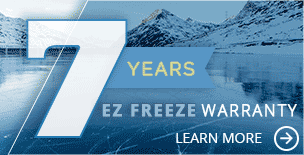Please view this video to learn about receiving your new refrigerator, freezer or stove:
We know that most of our customers have not experienced deliveries of large items and want to help to make this as easy as possible! We would appreciate it if you would read the below information in it’s entirety. The basic idea is INSPECT, NOTATE, SIGN….
- Inspect for Damage
- Notate any damage to the box (any dings, rips, tears) on the delivery receipt BEFORE you sign it. Refuse the shipment if the item is significantly damaged.
- Sign the delivery receipt
Freight Damage
Since your shipment is being transported via freight truck, and we wanted you to be aware of your rights and responsibilities as the end recipient. There are a lot of things that can happen between the us and your delivery location; therefore we are asking you to do a very small amount of work to protect yourself, and us.
When your item is ready to be delivered and you chose a residential delivery, the freight carrier will contact you to arrange delivery. If for any reason your shipment cannot be delivered (including but not limited to an undeliverable address, no liftgate requested in advance, a responsible party is not available to sign for the shipment, or inability of the carrier to contact or otherwise arrange a delivery appointment with you), you are responsible for any return freight charges or storage fees incurred.
To ensure that you are receiving what you ordered, and in acceptable condition, the National Claims Council Regulations specify that you must inspect, examine, and inventory your shipment as it is unloaded. Freight shipments cannot be just left at the delivery location, therefore making and keeping your delivery appointment is highly important. On arrival, inspect the shipment immediately for obvious signs of damage.
Any and all shortages and damages must be written on the Bill Of Lading or Freight Bill. Should you determine that any items are damaged or missing, you MUST note the item, the discrepancy, and the condition before you sign it! If you notice significant damage that cannot be easily repaired, please refuse the shipment. The carrier will return the damaged freight to us. Call us as soon as possible to let us know you refused the shipment. If the item could be repaired or you would like to retain the unit at a discount, please note the damage on the delivery receipt. We will file a claim and order parts or offer a discount once the freight company concludes the claim.
You should open cartons and containers.
If there is the slightest doubt that the merchandise is damaged (concealed or not) it must be noted on the Bill Of Lading or Freight Bill, or the liability to prove that the delivering carrier is responsible for the damage. If you do not note damage on the carrier’s paperwork, the damage will become your responsibility.
Do not be intimidated by the driver.
They cannot leave until the Bill Of Lading or Freight Bill is signed (regardless of how much in a hurry they are or how late they are). The carrier’s driver should help you receive your shipment and answer your questions. While your driver is there, compare the pieces of freight you are receiving to your carrier’s freight bill. When you’ve determined that the condition and quantity of your freight is acceptable, you can then sign the delivery receipt. The driver will provide you with a copy, taking the signed copy with them (as a delivery receipt). If one is not offered, request one, as is your right. The Bill Of Lading or Freight Bill is the only documentation of the condition of a shipment when it arrives at your location, and without this document, we cannot hold others accountable for items damaged or missing.
Your signature without any notes of damage or discrepancies on the delivering carrier’s freight Bill Of Lading (BOL) constitutes acceptance of the merchandise as is and in good order. If you do not inspect before signing you are, for all practical purposes, waiving the right to collect on a damage claim even if the damage is discovered later.
If there is discovered damage: if the box, crate, or merchandise is visibly damaged, refuse the delivery and contact us immediately to request a Return Authorization number so the merchandise can be shipped back to its origin at no charge. Please also notify us of the situation as quickly as possible so we can follow-up on our end to assist with any required procedures.
If there is concealed damage: Although we strongly recommend inspecting the shipment prior to signing the delivery receipt, some still do not do so. If the consignee or their representative sign for the shipment, and then at a later time discover that there is some damage not noticed at delivery (called “concealed damage”), then a claim will need to be filed by the consignee against the freight company. As a shipment is technically the property of the consignee once it is signed for, it is the consignees responsibility to pursue a damage claim for replacement or compensation.
In the event of concealed damage, it is vital that you immediately document and photograph (if possible) the packaging and the damage and contact the freight company IMMEDIATELY. You must keep the packaging. Do not move the item, but call the carrier and report the damage. They will begin a concealed damage claim and ask for an inspection. You must also notify us so that we are aware of the situation and can be of assistance if required. The inspector will determine if the damage was possibly carrier caused.
Please note: If the consignee has signed for the shipment indicating there was no damage noted at time of receipt, the consignee would then have to take up their claim with the freight carrier if concealed damage becomes apparent after receipt. Many people order products in advance of need, and wait until it is to be installed to finally check the condition of the product (sometimes weeks or even months have passed); in these situations, it is the consignee’s sole responsibility to contact the freight carrier and pursue a claim.
Remember: in cases of concealed damage, you signed the document saying everything was OK; a report and a claim must be filed with the carrier immediately – the sooner concealed damage is discovered and reported, the better.
Additional points to consider:
- Whenever signing for freight, always write “SUBJECT TO INSPECTION”
- Whenever possible, inspect the freight before you sign.
- Note on the freight bill any obvious damage at the time of delivery (i.e. box corners crushed, tears, rips, slices, marks etc.); be specific.
- If you suspect internal damage, open immediately.
- Even if no damage is suspected, open the carton(s) within 24 hours and make a thorough inspection.
- After noting the freight damage on the bill of lading, you must call the carrier, and also notify us of a damaged shipment. We will ask you to fax us a copy of the bill of lading that notes the freight damage.
- Hold all damaged goods and their packaging materials, in the original location, for inspection by the carrier.
Further measures that may help in the claim process include the following:
- Taking digital photography of the damage. If possible, photographs of the equipment still on the truck will limit your liability.
- Report the damage to the carrier and request they start a claim. Preferably, the call should be made before the driver leaves the site. Then, notify us.
- Request an inspector.
- Keep a copy of the Bill Of Lading or Freight Bill noting the damage and the driver’s signature.
It is the responsibility of the person that signs for received items to inspect and note any and all problems before the delivery person leaves. You have heard the term “FOB” (Freight On Board) – this term simply means that once the carrier picks up the material from the factory/supplier, the factory/supplier is no longer responsible for the material.
If you have someone signing the freight bill for you, for whatever reason, they are acting as your representative; you should inform them that they should check for missing or damaged items. If the freight is signed for without notating damaged or missing pieces, it is almost impossible to get the freight companies to take responsibility.
We realize this can be a time consuming process, but much of the hassle can be eliminated with prompt, well-documented action with the carrier.
We cannot be held responsible for freight damage that has been signed for or missing pieces not noted on the BOL; we will help you deal with the freight company, but you must call the freight inspector and you must file the claim. Ultimately, it is the Freight Company’s responsibility to deliver the shipment in good condition, and it is the consignee’s responsibility to inspect and sign for the products and notate any missing or damaged pieces.
Please note: Recent changes have been made to the National Motor Freight Classification (NMFC) rules regarding concealed damage notifications. As of Saturday, April 18, 2015 the National Motor Freight Traffic Association (NMFTA) has reduced the time shippers are allowed to report concealed damage to the carrier from 15 days to 5 days. This applies to all LTL shipments. This means that if you fail to report concealed damage within 5 days, it will result in your inability to file a freight claim with the carrier.
FREQUENTLY ASKED SHIPPING QUESTIONS
Q. “My order is shipping via freight truck; what should I look for when it gets here?”
A. Please note that freight shipments are delivered “curb-side”, meaning that the driver is only responsible for delivery of the shipment to the property – not to the garage, or inside the location. Unfortunately, there are a lot of things that can happen between the manufacturer and your delivery location; therefore we are asking you to do a very small amount of work to protect yourself, and us.
We strongly recommend inspecting the shipment prior to signing the delivery receipt, but some still do not do so; to ensure that you are receiving what you ordered, and in acceptable condition, the National Claims Council Regulations specify that you must inspect, examine, and inventory your shipment, as it is unloaded.
- On arrival, inspect the shipment immediately for obvious signs of damage. Any and all shortages and damages must be written on the Bill Of Lading or Freight Bill. Should you determine that any items are damaged or missing, you MUST note the item, the discrepancy, and the condition before you sign it! Then call the freight company to report any problems.
- You should open cartons and containers. If there is the slightest doubt that the merchandise is damaged (concealed or not) it must be noted on the Bill Of Lading or Freight Bill, or the liability to prove that the delivering carrier did the damage becomes your responsibility.
- Do not be pressured or intimidated by the driver. They cannot leave until the Bill Of Lading or Freight Bill is signed (regardless of how much in a hurry they are or how late they are). The carrier’s driver should help you receive your shipment and answer your questions. While your driver is there, compare the pieces of freight you are receiving to your carrier’s freight bill. When you’ve determined that the condition and quantity of your freight is acceptable, you can then sign the delivery receipt. The driver will provide you with a copy, taking the signed copy with them (as a delivery receipt). If one is not offered, request one, as is your right. The Bill Of Lading or Freight Bill is the only documentation of the condition of a shipment when it arrives at your location, and without this document, we cannot hold others accountable for items damaged or missing.
Q. “When should I sign for the shipment?”
A. Your signature on the delivering carrier’s freight Bill Of Lading (BOL) constitutes acceptance of the merchandise “as is” and in good order. If you do not inspect before signing you are, for all practical purposes, waiving the right to collect on a damage claim even if the damage is discovered later (known as concealed damage). So, you should only sign for the shipment once you are satisfied with the condition of the shipment.
Q. “What if the shipment arrives damaged?”
A. If the box, crate, or merchandise is visibly damaged, refuse the delivery and contact us immediately to request a Return Authorization number so the merchandise can be shipped back to its origin at no charge. Please also notify us of the situation as quickly as possible so we can follow-up on our end to assist with any required procedures. Please be aware that, as a shipment is technically the property of the consignee once it is loaded onto a freight truck, it is the consignee’s responsibility to pursue a damage claim for replacement or compensation.
Q. What is concealed damage?
A. Concealed damage is damage which you did not notice when you first accepted your shipment or was hidden from your sight.
Q. “What if I don’t see any damage until after the freight driver has left and I have signed the BOL?”
A. This must be reported immediately. If the consignee has signed for the shipment indicating there was no damage noted at time of receipt, the consignee would then have to take up their claim with the freight carrier if concealed damage becomes apparent after receipt. Many people order products in advance of need, and wait until it is to be installed to finally check the condition of the product (sometimes weeks or even months have passed); in these situations, it is the consignee’s sole responsibility to contact the freight carrier and pursue a claim.
In the event of concealed damage, it is vital that you immediately document and photograph (if possible) the packaging and the damage. You must keep the packaging. Do not move the item, but call the carrier and report the damage. They will begin a concealed damage claim and ask for an inspection. You must also notify us so that we are aware of the situation and can be of assistance if required. The inspector will determine if the damage was possibly carrier caused.
Remember: in cases of concealed damage, you signed the document saying everything was OK; a report and a claim must be filed with the carrier immediately – the sooner concealed damage is discovered and reported, the better.
Q. “What if I have my neighbor sign for me because I am unable to be there for the delivery?”
A. If you have someone signing the freight bill for you, for whatever reason, they are acting as your representative; you should inform them that they should check for damaged items. If the freight is signed for without notating damaged or missing pieces – regardless of whether you or your representative signed for it – it is quite difficult to get the freight companies to take responsibility.
Q. “Will you replace my order if it is delivered damaged and I sign for it?”
A. We cannot be held responsible for freight damage that was signed for; we will help you deal with the freight company, but you must call the freight inspector and you must file the claim. Ultimately, it is the Freight Company’s responsibility to deliver the shipment in good condition, and it is the consignee’s responsibility to inspect and sign for the products and notate any damage.
Q. “If I order a very heavy item, will the freight driver deliver to wherever I need it on the premises?”
A. In short, no. The freight carrier’s responsibility is to deliver within the property line; once it has been delivered to the address supplied, and the Delivery Receipt has been signed, the driver has fulfilled their obligation. Freight will be unloaded at the delivery site immediately adjacent to the delivery vehicle only.
Q. “Will the freight driver take the shipment off of the truck for me?”
A. The freight truck driver is only responsible for getting the shipment to the delivery site (please note that the shipment will be delivered only to the property – not into the garage, or inside the location); if there are no means to remove the shipment from the truck at the delivery site and you did not have a liftgate service scheduled, the shipment may be returned to the freight carrier hub, where a different truck may be assigned for the delivery, which will incur additional costs that are the consignee’s responsibility. If a lift gate was requested at the time the order was placed, then the shipment will be removed from the truck by the driver. However, if no lift gate was requested in advance, they are not automatically supplied. If delivery is attempted without the means to remove the shipment from the truck, you will be responsible for return freight charges and any storage fees incurred. The best way to avoid this is to request a lift gate when the order is placed, listed as an option for a nominal fee on the page where the item(s) were ordered.





